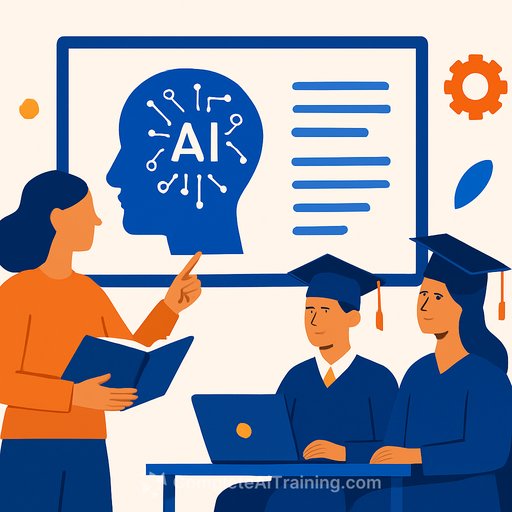Maximising graduate employability through AI skills
Students and employers are using AI every day. Universities are catching up in parts, but the approach is inconsistent. The path forward is simple: embed practical, responsible AI use into teaching, assessment and student support.
In a recent panel discussion, leaders from universities and industry agreed: graduates need AI literacy, ethical awareness and the capacity to learn continuously. Employers now treat AI fluency as a core skill, not a niche advantage.
What employers expect now
Responsible use of AI is a teachable skill. Employers want graduates who can judge when, why and how to use AI - and when not to. That means building "boundary-spanning" skills that connect disciplines, tools and outcomes.
Curricula should move beyond theory. Put real tools in students' hands and require transparent AI use in projects, labs and placements. Make the standard of evidence clear: cite the tool, the prompt, the output, and the human review.
Teach students to learn, then keep learning
Tools will change again next semester. The durable advantage is learning to learn. Build meta-skills: problem framing, experimentation, feedback loops and reflective practice.
Give students cycles of use-critique-improve. Ask them to compare AI outputs, stress-test results, and document how their method changed.
Build an AI-enabled ecosystem, not one-off workshops
AI should live where students already work. Productivity suites now include strong AI features across writing, data, meetings and admin. Adoption at scale shows what's possible across the entire student journey.
If your institution uses Google Workspace for Education, align teaching scenarios with its AI features and require transparent usage in assignments. See product details and policies on the official site: Google Workspace for Education.
From skills to competencies
Skills are what students can do. Competencies are how they apply those skills in context. Design tasks where students use AI to plan, produce, and then justify their decisions against ethical, legal and quality standards.
Ask: did the student choose the right tool, set the right constraints, validate outputs and improve results?
Rethink assessment and academic integrity
AI has exposed weak assessment design. Shift from product-only grading to process-evidence grading. Require prompt logs, comparison of alternatives, critique of limitations and a human-edited final.
Teach critical engagement: what the model did, what it missed, and how it could mislead. Reward discernment and verification.
Action checklist for the next 90 days
- Publish a clear policy on responsible AI use for students and staff (use, citation, privacy, accessibility, consequences).
- Embed AI tasks into at least three core modules per programme (not optional extras).
- Run a faculty sprint: co-design two AI-enhanced assessments per course with process evidence requirements.
- Stand up a student "AI lab" space with tool access, guidance and peer mentors.
- Adopt an AI use declaration in all submissions (tool, prompt, output, human edits, sources checked).
- Integrate employer briefs that require AI-supported research, analysis and reporting.
- Create an ethics and data policy primer; align with sector guidance such as UNESCO's recommendations: UNESCO: Ethics of AI.
- Track outcomes: time saved, error rates reduced, feedback quality, employability signals.
Quick wins this term
- One-hour AI literacy session embedded in induction and study skills.
- "AI plus" assignments: students must improve an initial AI draft and explain the changes.
- Portfolio requirement: include a real example of AI-assisted work with verification steps.
- Employer roundtable on responsible AI use in your discipline.
Support for educators
If your team needs structured, up-to-date training, explore role-based options here: AI courses by job. Focus on practical workflows, assessment redesign and ethical use.
The panel
- José Esteves, dean and president of the executive board, Porto Business School
- Peter Mandalh, CEO, Skellefteå Universities Alliance
- Miranda Prynne, editor of Campus, Times Higher Education (chair)
- Gonzalo Romero, head of Google for Education, Iberia
- Tom Stoneham, professor of philosophy, and ethics lead for the UKRI Centre for Doctoral Training in Safe AI Systems, University of York
- Tim Vorley, pro vice-chancellor for arts, humanities and social sciences, Oxford Brookes University
The takeaway is clear: make AI a normal part of how students learn, build ethical habits, and assess the process. Graduates who can use AI responsibly and think critically will be hired first - and progress faster.
Your membership also unlocks:






